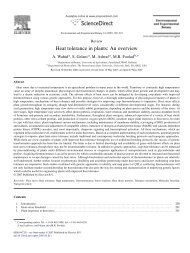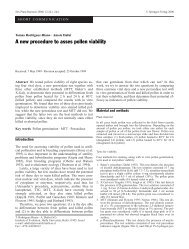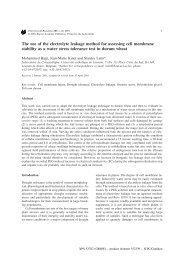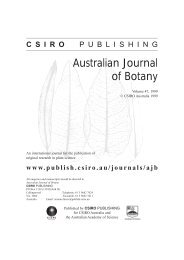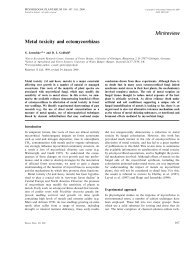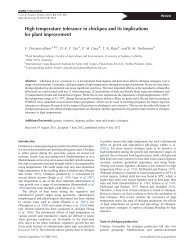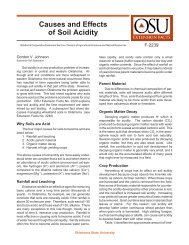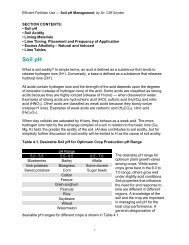Australian Trees for the Rehabilitation of Waterlogged and Salinity ...
Australian Trees for the Rehabilitation of Waterlogged and Salinity ...
Australian Trees for the Rehabilitation of Waterlogged and Salinity ...
Create successful ePaper yourself
Turn your PDF publications into a flip-book with our unique Google optimized e-Paper software.
704 D. T. Bell<br />
However, <strong>the</strong> ability <strong>of</strong> E. micro<strong>the</strong>ca to retain leaves already enhanced growth potential.<br />
Clones <strong>of</strong> E. camaldulensis with <strong>the</strong> greatest tolerance that were stressed <strong>for</strong> salinity <strong>and</strong><br />
drought (Farrell et al. 1996a) <strong>and</strong> waterlogging/salinity <strong>and</strong> alkalinity (Farrell et al. 1996b)<br />
maintained leaf area <strong>and</strong> continued to transpire water, even while under stress. Water use in a<br />
plantation <strong>of</strong> E. camaldulensis <strong>and</strong> E. tereticornis in sou<strong>the</strong>rn India was strongly influenced<br />
by total leaf area index (Roberts <strong>and</strong> Rosier 1993).<br />
Tolerance to waterlogging <strong>and</strong> salinity is usually related to combinations <strong>of</strong> both morphological<br />
<strong>and</strong> physiological adaptations. The morphological changes are usually preceded by<br />
changes in stomatal aperture, transpiration <strong>and</strong> net photosyn<strong>the</strong>sis (Kozlowski 1984). Longterm<br />
tolerance to waterlogging <strong>and</strong> salinity may <strong>the</strong>re<strong>for</strong>e be related to <strong>the</strong> degree to which<br />
morphological–physiological interactions to stress are affected (van der Moezel et al. 1989b).<br />
A genotype may take up salts in <strong>the</strong> transpiration stream, yet shunt excesses into senescent<br />
tissues, <strong>and</strong> allow younger leaf tissue to maximise photosyn<strong>the</strong>sis <strong>and</strong> net carbon gain, <strong>and</strong><br />
grow with periodic bursts <strong>of</strong> activity. O<strong>the</strong>r genotypes may restrict water <strong>and</strong>, <strong>the</strong>re<strong>for</strong>e, salt<br />
uptake, retain all leaves with increased salt concentrations through osmotic adjustment <strong>and</strong><br />
produce a more constant, but slower rate <strong>of</strong> instantaneous growth. In <strong>the</strong> search <strong>for</strong> genotypes<br />
to de-water agricultural catchments, those that retain leaf area <strong>and</strong> maintain high stomatal<br />
conductance under saline conditions, but exclude salts from <strong>the</strong>ir roots, would be favoured.<br />
Root Expanse Differences <strong>and</strong> Regrowth Potential<br />
In addition to attributes <strong>of</strong> above-ground structures <strong>and</strong> function influencing water uptake<br />
from waterlogged <strong>and</strong> saline environments, attributes <strong>of</strong> <strong>the</strong> root structure <strong>and</strong> water <strong>and</strong> salt<br />
uptake functions differ between species (Passioura 1988). Plants naturally fringing permanent<br />
wetl<strong>and</strong>s or inhabiting ephemeral swamps must regrow root tips when groundwater again<br />
becomes available. Eucalyptus camaldulensis has long been known to possess both a surface<br />
root system <strong>and</strong> a deep, tap <strong>and</strong> sinker root system (Awe et al. 1976; Bell et al. 1993b).<br />
Mens<strong>for</strong>th <strong>and</strong> Walker (1996b) have shown that <strong>the</strong> dynamic root development system <strong>of</strong><br />
Melaleuca halmaturorum adjusts root growth <strong>and</strong> water uptake to parts <strong>of</strong> <strong>the</strong> pr<strong>of</strong>ile where soil<br />
water is readily available <strong>and</strong> in this way maintains transpiration at a rate required <strong>for</strong> continued<br />
growth. This species absorbs salts, reducing plant water potentials to almost –7 MPa; it can<br />
<strong>the</strong>n utilise saline groundwater during summer when surface soils are too saline <strong>for</strong> water<br />
uptake (Mens<strong>for</strong>th <strong>and</strong> Walker 1996a). Akilan et al. (1997b) have shown that differences in<br />
<strong>the</strong> ability to regrow root tissues account <strong>for</strong> <strong>the</strong> relative seasonality <strong>of</strong> water use in clones <strong>of</strong><br />
Eucalyptus camaldulensis. In alley-farming treatment comparisons in marginally saline<br />
l<strong>and</strong>scapes near Katanning, Western Australia, Casuarina obesa was found to have less <strong>of</strong> an<br />
effect on associated pasture grasses than some species <strong>of</strong> Eucalyptus. The implication from<br />
<strong>the</strong> pattern <strong>of</strong> water use was that C. obesa exploits a more vertical volume <strong>of</strong> soils than do<br />
eucalypts (Scott <strong>and</strong> Crossley 1996). Recent studies using carbon isotope discrimination on<br />
water-use efficiency <strong>for</strong> a range <strong>of</strong> eucalypts found that <strong>the</strong> deeply rooted phreatophytes were<br />
clearly distinguished from those species that depend solely upon soil moisture derived from<br />
rainfall (Anderson et al. 1996). The ability to access groundwater tables allows phreatophytes<br />
to be more pr<strong>of</strong>ligate in water use to maximise carbon gain. However, comparisons <strong>of</strong> carbon<br />
isotope discrimination between several phreatophytic eucalypts in an attempt to relate dry<br />
mass allocation <strong>and</strong> water-use efficiency as <strong>the</strong> basis <strong>for</strong> selecting specific genotypes was less<br />
successful (Le Roux et al. 1996). In <strong>the</strong> search <strong>for</strong> high-water-use species to rehabilitate<br />
damaged agricultural catchments, low-water-use efficiency (large amounts <strong>of</strong> water<br />
transpired in relation to <strong>the</strong> amount <strong>of</strong> carbon fixed) would be an attribute <strong>for</strong> selection <strong>of</strong><br />
trees to per<strong>for</strong>m <strong>the</strong> task <strong>of</strong> transpiring excess catchment water.<br />
Effect <strong>of</strong> Waterlogging <strong>and</strong> <strong>Salinity</strong> on Nitrogen Fixation in Acacia<br />
Species with tolerance to waterlogging <strong>and</strong> salinity, plus high protein content, have appeal<br />
<strong>for</strong> use in agricultural catchments as sheep fodder. However, species <strong>of</strong> Acacia tend to be only



